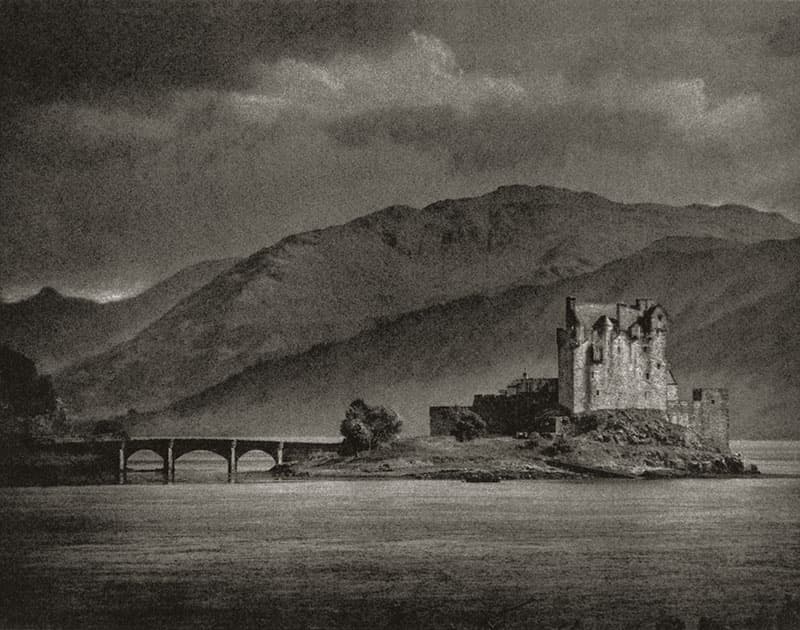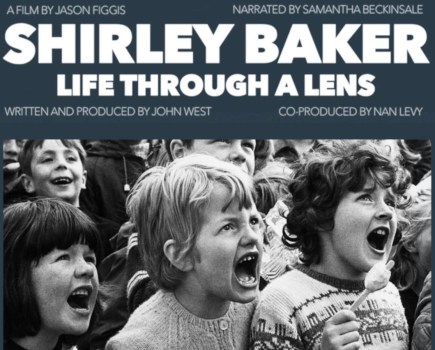Photo Insight with Andrew Sanderson

A renowned photographer, tutor, author and Ilford Master Printer,
Andrew Sanderson
offers practical
tips on working with film and
traditional darkroom techniques
This is a shot of Eilean Donan Castle on the west coast of Scotland. Although I had never heard of the place, and never seen it, there has been a castle on this site since the early 13th century.
This photograph of the castle was taken in 1988, while I was on a scenic holiday in the north-west of Scotland with my then girlfriend. I was driving around looking for things to photograph, and as I was going north on the A87 I passed this castle on the left. I was really taken with it and stopped at Aird Point to park up and look across at the view. I walked down to a small jetty and along that to the edge of the water to take just one shot. The castle looked so picturesque that I didn’t have any difficulty creating an image I was pleased with.
Other images I see of this scene tend to be from the viewpoint on the bridge, as you approach the castle. Very few people seem to venture round to this spot, making this shot a little different.
I think the original picture was taken on a Pentax Spotmatic with a SMC Takumar 105mm f/2.8 lens. The print you see here was made from a 6x4in paper negative that was created in the darkroom later. Using the paper negative process in this way allows me more flexibility in composition. Generally, long lenses are not used on large-format cameras, so I wouldn’t have taken this with paper in the camera.
Later, I made a paper negative and added pencil work on the back, altering the tones in the final print. These days, I use paper in the camera and tend not to manipulate images. Back then, I was doing more things like this. I do enjoy it, but it is time-consuming.
To get this effect you shoot on any film stock and print onto 5x7in paper in the darkroom, doing any dodging and burning needed. Then, on the back of print, you can add tone using a pencil, darkening areas to accentuate clouds and so on.

That goes in an enlarger, which is then projected onto a baseboard. A second layer of pencil can be used to add in highlights rather than shadow. I dramatised the clouds slightly in this picture. I didn’t add any, but I did make them more apparent. The final paper I used for the print gave the textured look you see here.
At the time, I wasn’t aware of how often this castle is photographed, until my father recognised it from my picture. According to him, ‘That castle is on any number of biscuit tins and placemats’.
As I said earlier, while I had never heard of Eilean Donan Castle, it has been on that spot since the 13th century. Eilean Donan, or island of Donan, is probably named after the 6th century Irish saint, Bishop Donan, who came to Scotland in around AD 580. There are several churches dedicated to Donan in the area, although the first fortified structure was not built on the island until the early 13th century as a defensive measure.
Over the centuries, the castle itself has expanded and contracted in size, eventually falling into ruin. That was until Lieutenant Colonel John MacRae-Gilstrap bought the island in 1911. Along with his Clerk of Works, Farquhar MacRae, he dedicated the next 20 years of his life to the reconstruction of Eilean Donan, restoring the castle to its former glory. It was rebuilt according to the surviving ground plan of earlier phases and was formally completed in 1932.
I have never been back to Eilean Donan since, which is a shame because it’s a beautiful spot. It’s odd that you can visit a place and then almost forget that it exists until you look back over your photographs.
These days Eilean Donan offers photographers, and other visitors, a webcam, so you can see the location and weather, and plan your shoot before you go. There seems to be a steady stream of people visiting the castle, but I don’t remember anyone else there on the day we visited. Maybe its starring role in the film Braveheart has helped to put the castle back on the tourist map.
To find out more about the castle, visit www.eileandonancastle.com.
Andrew Sanderson was talking to Debbi Allen

If you would like to read more about paper negatives, Andrew’s book Paper Negative Photography is available from www.blurb.com, price £15







